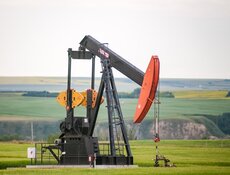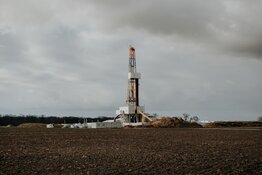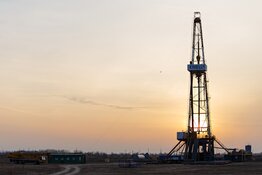Matt Badiali: Sure. There have been several big pre-salt or sub-salt discoveries offshore South America, offshore Brazil. The ability to gather much more detailed seismic energy information is driving these new discoveries. They go out and collect seismic information, shooting sound waves through the ocean into the sediment beneath the ocean floor. The further away, the deeper it gets into the earth, the noisier it is. With the advances in computing power, they can actually filter out that noise and see deeper and deeper.
And salt created its own special problem because it attenuates the actual sound you put in; in the past, you couldn't see underneath it with seismic data. They can do it now with the algorithms they've developed and faster, stronger computers.
Having found the oil is one thing. The problem is that the ability to see the oil got ahead of the ability to develop it. This oil is going to require some of the deepest wells ever drilled and the deepest production infrastructure ever placed. Superlatives like that concern me, because the costs go up. Because it's never been done before, you can probably add a zero to the price tag when you bid out this oil pipeline. Making money on this oil will be a challenge for Petrobras (NYSE:PBR).
And as you mentioned, there is a new discovery in offshore Sub-Saharan Africa, kind of the horn of West Africa. Anadarko Petroleum Corporation (NYSE:APC) and Tullow Oil plc (LSE:TLW.L) have made a couple of really exciting discoveries there. They're exciting because they're separated by about 700 miles, stretching from Ghana on the east to Sierra Leone on the west. I think Exxon Mobil Corporation (NYSE:XOM) is competing with one of the Chinese oil companies to get a 25% stake in the Jubilee Field, which is the one south of offshore Ghana.
TER: This might move the peak oil date farther ahead.
MB: I think this is a really, really massive play. And yes, if that's the case, it pricks the peak oil balloon again for another decade or so. When you start putting the discoveries together on this one, and consider some of the work that Anadarko has put together, you're looking at 6 billion barrels conservatively.
That's very similar to the Tupi discovery. So offshore Sub-Saharan Africa could be the next offshore Brazil, in which case we have lots and lots of oil out there. We just have to figure out how to develop it.
TER: And at what price.
MB: David O'Reilly, CEO of Chevron Corporation (NYSE:CVX), came out last week saying there's going to be a shortage of oil in the next decade and he's pointing to $100-plus a barrel again. His line of reasoning is rational. For instance, Venezuela basically uses all of its oil revenues to subsidize bizarre projects such as donating heating oil to people in the United States, keeping Chavez in power. Basically, Mexico did the same thing and ran themselves right into the ground. They are on track to becoming net oil importer from one of the biggest oil exporters in the world. And Mexico has the potential of doing the same thing. We've already seen it with Indonesia, which was one of the founding members of OPEC but got kicked out because they became a net oil importer a couple of years ago.
Oil fields require sustaining capital. You have to keep drilling. You have to rehabilitate the fields. You have to spend money on them. They're not a golden goose. A lot of these countries where the sole source of GDP is oil don't do that. They spread the wealth around and that's a problem.
The other thing that you see—and you see it reflected in the mix of oil-to-gas reserves in a lot of these big companies—is that the discoveries of oil are declining and they're replacing oil production with natural gas reserves. It's very subtle because most oil companies present their data in BOE (barrels of oil equivalent), which is oil and gas combined and published in barrels. It's kind of a slick way to not tell you that they're actually finding natural gas and not oil.
So we could see more robust oil prices going forward. We hit $65–$70 a barrel in 2005, 2006, 2007, before things really got crazy, and we're right back in that same groove. This isn't out of line. I think $35 a barrel earlier this year was a market over-reaction to the catastrophe. Everybody was looking for the end of the world and when it didn't happen, things are starting to get back to normal.
TER: Are you talking about a temporary spike due to the oil-producing countries depleting reserves and we don't yet have the oil from these deepwater finds?
MB: If these countries continue to lose production, it's going to be very, very difficult to replace it. So even when you bring these massive oil discoveries online, that's going to take a long time—five, six, eight years down the road to build these pipes and put in the infrastructure they need. These are discovery stage. It takes a long time to go from discovery to 100,000 barrels a day, 300,000 barrels a day.
Part of the equation that's still in limbo is Iraq. I think they're shooting for 10 million barrels a day, and that's oil that's inexpensive to produce, is land-based, and just needs the infrastructure to be upgraded. That's going to be the real hinge on what happens to oil prices. If Iraq doesn't get its act together, we'll have to rely on offshore oil fields to take up the slack. Then the oil price is going to be very, very cyclical. If there's a storm, if there's a riot, it's going to get bad and oil prices will spike.
I won't say oil is never going to go below $100 a barrel again, but I certainly am further over in the $100 a barrel camp today than I was April of 2008 when people were saying it was going to go to $200 a barrel and I couldn't figure out why it was at even $100.
TER: In our last conversation, you were really hot on the oil services sector—partly because you expected the oil price to rise (which it has) and also because you saw the services sector trading for just about book value. You gave us a couple of recommendations, which have doubled or tripled since then. What do those oil service sector companies look like now in terms of investment opportunity?
MB: When you take gains like that, things get too expensive. We were buying those shares at fractions of book value. I think Parker Drilling Company (NYSE:PKD was trading at 30 cents on the dollar in terms of the value of its rigs. When oil is cheap, the market looks at drill rigs sitting in parking lots and assigns them basically no value at all. I wanted things to get a little better and I knew we would make money that way—and we did. But now they're trading at multiples of book value again and things could get worse.
The nice thing about the oil and gas industry is it's very cyclical, so we get these opportunities. Right now I'm less interested in the service companies. There are sectors of it that I probably should be paying more attention to right now. When we talked in April, the number of onshore rigs drilling specifically for oil went from 224 to 204. They were getting clobbered. Today that's rebounded all the way up to 309 rigs from its bottom in June. So, our timing on the investment was absolutely perfect.
Gas drilling rigs are starting to come back a little bit now, but they didn't bottom until the middle of July. They went from 800 in April to 675 rigs in July and they're back up to 721. To me that also speaks to the oil-versus-gas situation I mentioned earlier—300 rigs are out there drilling for oil and 700 are drilling for natural gas. These companies are replacing their reserves with natural gas, so there could be less oil available in the future.
TER: So if not oil services anymore, where do you see the action these days?
MB: I'm very excited about companies that have oil production that's not the cheapest production in the world, so maybe they're paying $25 or $30 a barrel to produce it. But as the oil prices go up, their earnings rise faster than lower cost producers. They have leverage to the oil price, so now I think gains will be made in those kinds of companies. These are companies that maybe produce heavy oil or tar sand.
But my favorite group of companies right now does enhanced oil recovery (EOR) or tertiary recovery. They go back into oil fields discovered around the turn of the last century, produced millions or billions of barrels of oil, and then were left for dead in the '70s or '80s or '90s when oil hit $10 or $15 a barrel.
The Lawrence Field in Illinois is a great example. It probably still has 50% or 60% of its original oil in place. They produced maybe half of it, so a little company is back there now and injecting a chemically that acts basically like Dawn liquid dish soap.
TER: Dawn?
MB: Dawn takes the grease out of your way. It's not really Dawn, but a surfactant. When they put the chemical into the reservoir, it kills the surface tension and the oil mixes with the water. They figure they're going to get 20% of the original oil out. That's hundreds of millions of barrels. And they're going to do it for $25 or $30 a barrel. If oil hits $90, they'll make a fortune. People are starting to pick up on it, but they haven't quite gotten there yet.
I like that better than, say, tar sand, because it's light, sweet crude—the real stuff. A couple of other companies that I really like are injecting CO2 into oil fields to lower the surface tension and loosen up the oil. With today's society seeing carbon dioxide as a bad actor, an oil company that's injecting carbon dioxide into its oil field to produce low-carbon oil is going to get a lot of attention. I think they will get a higher multiple for that oil, whether it's deserved or not.
TER: Who are the companies?
MB: Probably 10 companies are doing this kind of stuff. Marathon Oil Corporation (NYSE:MRO) has done a lot of this, but I haven't recommended them because it represents only a small fraction of their production. EnCana Corporation (NYSE:ECA) does this too. Marathon and EnCana are the two big guys.
TER: Which one is in Illinois?
MB: The company that's working in the Lawrence Field is Rex Energy (NASDAQ:REXX). It has absolutely exploded, though, not because of the EOR work, but because they're based in State College, Pennsylvania, right in the heart of the Marcellus Shale region and they have a partnership in the Marcellus. As soon as natural gas prices turned around, Rex exploded out of the gate.
TER: Do you have a target for Rex?
MB: No. I typically don't do targets on the upside. I let the market tell me because my experience with a lot of these smaller companies is that I would be way too conservative. I basically told people to buy it up to $8 and it's closing in on $10.
We don't know what the oil price will be when the Lawrence Field production comes on and how much money they're going to make. But at $90 a barrel, the economics of that field look much, much better than they did when I first recommended it, so that's pretty exciting.
TER: And when do they anticipate production?
MB: The first or second quarter of 2010. I think the Lawrence Field story is fantastic. And bear in mind, this is a region of the United States that's been hit particularly hard in the downturn and this oil company is putting people to work on an old oil field that was discovered in 1906.
To tie this back to Brazil, Petrobras very quietly put together a $145 million research project to inject CO2 into one of its fading onshore oil fields and it was pretty clear that they will do this to their offshore fields too, because it almost guarantees an additional 20% production. The people at Petrobras are no dummies. They want to get as much oil out of these fields as possible, so I wouldn't be surprised if they build the infrastructure for their CO2 floods on the front end rather than trying to retrofit things.
TER: You said maybe 10 companies are doing enhanced oil recovery. Can you tell us about any more of them?
MB: BreitBurn Energy Partners L.P. (NASDAQ:BBEP), I believe, is doing some EOR work in California. And Venoco, Inc. (NYSE:VQ), which—believe it or not—has oil wells in downtown Los Angeles, also does this. They have elaborate façades; you wouldn't even know you were walking by an oil well.
TER: Are you looking at any other oil plays?
MB: This is the perfect time to look at leveraged oil. Suppose a company produces oil for $30 a barrel and sells it for $40. The market says it will value the company at 10 times earnings. If this company then doubles its production or the oil price goes up by $10, it doubles its earnings. On a P/E multiple, that doubles the market cap. It usually doesn't work quite that nicely, but that's the way leverage to your commodity works.
With the higher-cost producers—EOR, heavy oil, tar sands—where their production costs are $25 or even $35 a barrel, that's a very nice increase in share price if oil goes from $80 to $90. So that's kind of what I'm looking at across the board.
TER: So do both heavy oil and tar sands provide more of that leverage?
MB: They both do. They're both high-cost production, basically. But you don't want to buy these high-cost producers in an environment where the price of the commodity could fall. That's our biggest risk. If the dollar strengthens, the price of oil will come down and these high-cost producers will fall because that leverage also works in reverse. But I think we're going to hit $90 before we hit $50; that's what I keep in mind.
TER: Other than these leveraged oil plays, what are you watching?
MB: I'm still really excited about Iraq. I think there's going to be some enormous discoveries. We recommended a company called Addax Petroleum Corporation in Iraq in May, because they had a discovery we really liked. I was really disappointed because we were only able to be in Addax for six weeks before Sinopec International Petroleum Exploration and Production Corporation (NYSE: SNP.N)bought it. But we made a 55% gain in those six weeks.
There are a couple of other oil companies in Iraq, but they trade mostly on foreign exchanges. Heritage Oil plc (LSE:HOIL; TSX:HOC) is in the process of merging with a privately held Turkish company, Genel Energy International. That's a spectacular oil company and I think they're going to make some big discoveries. But they haven't moved a blip lately because they're in the middle of a merger and the merger hit a couple of bumps.
Another company I recommended was working on a joint venture with the Iraqi government, the Iraqi State Drilling Company, to bring western drilling techniques into Iraq. Basically, Iraq has had no modern drilling since the '80s. It is the home of billion-barrel-plus fields with very, very low operating costs. If I were going to start an oil company, Matt Badiali Enterprises, I'd go to Iraq. My operating costs would be less because people still think of Iraq as a war zone, but I'd have a great chance of finding massive oil reserves. To me it's the best place for a small oil company to go to add a zero to its market cap, if it's willing to accept the political risk.
When I'm playing oil discovery, I'm looking at places where people are a little afraid to go, political risk over technical risk. That's the mistake that 90% of analysts are making with those offshore Brazil discoveries. There figure there's no political risk, that Brazil is as excited as all get-out, but the technical risk is enormous. When you make a mistake on a $4 billion oil pipeline, it's a problem. And there is political risk in Brazil that people are undervaluing.
TER: How so?
MB: Brazil has proposed to create a brand new company—a quasi state-owned, quasi public company—that will oversee all of these offshore oil fields and will take ownership in part of all fields held by foreign companies. And they're going to go to production sharing agreements (PSAs), where the foreign companies will get cash per barrel, but won't be able to book reserves. Knowing what I know about Brazil, I thought, "Man, they just legally added a whole other layer of graft to that system." This is just another way for Brazil to tax that oil discovery and to steal as much as they can.
This is a massive discovery but it's not going to be the oil industry's savior. As soon as the size of the deposits became clear, the country changed the rules. If Brazil isn't careful, it could go the same route as Venezuela and Indonesia.
TER: Could you give us a quick synopsis of your view of the geothermal market as an investment? It's been attracting a lot of attention of late.
MB: There are two very different investment theses behind some of the companies in this space. Ormat Technologies Inc. (NYSE: ORA) is a play on everybody else getting excited about geothermal. It does produce some geothermal energy, but it is more the general store for the geothermal industry.
And I think if any form of cap-and-trade passes that makes coal-generated electrical power much more expensive, Calpine Corp. (NYSE:CPN) is going to make a lot more money. I've actually visited the geysers, which is where Calpine produces a lot of its geothermal energy. They generate hundreds of megawatts and it's silent, the coolest thing in the world.
TER: It sounds as if geothermal appeals to you.
MB: It does. What really what gets me excited about geothermal is that it works. It's not solar and wind, which need subsidies; and it's not tidal energy that works well on some engineer's drawing board, but doesn't translate into the real world.
I've heard that every megawatt of wind or solar energy needs a megawatt of natural gas or some other consistent power source to back it up, because there's no way to store this energy. If you produce wind power and suddenly the wind stops blowing at peak hours, you have to be able to turn something else on and generate that electricity.
Geothermal works. It's an economic, 24-hours-a-day source of power, and it makes a lot of sense. That's why I'm glad to see these new mid-sized entrants into the geothermal space. I think it will be a race between Ram Power Corp. (TSX: RPG) and Magma Energy Corp. (TSX:MXY) to roll up the junior geothermal industry.
TER: Rick Rule and Ross Beaty. They're good friends, too.
MB: The fact that Ross (Magma's founder) got into this is very exciting, and Rick has been pounding the table on geothermal for a long time. So this is good. We're going to need every source of energy we can get. As China gobbles up more and more energy abroad and our population grows, we will need as much domestic energy production as we can. That's electricity and fuel.
I look at oil as not so much a source of electricity, but as a source of fuel for trains and boats and planes and cars, trucks. I look at natural gas, like coal, as a source of electricity.
I find it unbelievable how any carbon-producing fuel is suddenly bad. People getting angry about coal, to me, is a complete disconnect. I grew up about 50 miles from Three Mile Island. Remember all the horrors of the 1970s nuclear scares? Now we see green TV commercials with baby birds and bunnies and a nice lawn and an attractive couple who get their electricity from nuclear power. Talk about cyclical. Holy smokes.
Now coal's the bad guy. But if we're going to get rid of coal, we need more sources of electricity. That's where geothermal fits in. It's also going to spark the renaissance of natural gas, because we need a transitional fuel. If you want to get away from coal, you need something to produce electricity with and natural gas is going to be the source. You can build a natural gas plant far, far faster than you can build a new nuclear plant with far fewer regulations.
TER: That takes us into a whole other discussion. There's so much to talk about. You're in an exciting area.
MB: Oh, man, I love it. It's been spectacular and it's been fast, with opportunities flying by.
DISCLOSURE: Matt Badiali
I personally and/or my family do not own any of the companies mentioned in this interview.
I personally and/or my family am not paid by the companies mentioned in this interview.
A member of the Stansberry & Associates Investment Research team of editors, Matt Badiali produces the The S&A Resource Report, a monthly investment advisory that focuses on oil, energy and mining and sectors—from the biggest resource companies in the world to small-cap junior explorers. With "the global economy still in the grip of a long-term bull market for oil, precious metals and other natural resources the likes of which the world has never seen," his company says those are the sectors in which "demand is going through the roof, and one of the best places investors can have their money over the next few years."
Matt, who's spent the last four years flying all around the world digging up the best resource investments, has more than 15 years of experience as a hydrologist, geologist and a consultant to the oil industry. He holds a master's degree in geology from Florida Atlantic University and is pursuing his PhD at the University of North Carolina. He's also a regular contributor to Growth Stock Wire, a free daily pre-market briefing on trading opportunities.
Want to read more exclusive Energy Report interviews like this? Sign up for our free e-newsletter, and you'll learn when new articles have been published. To see a list of recent interviews with industry analysts and commentators, visit our Expert Insights







































